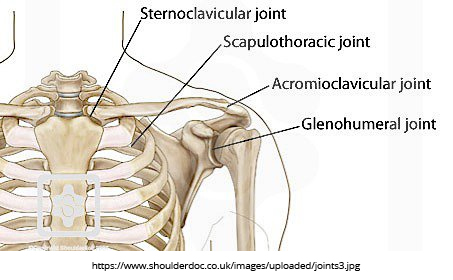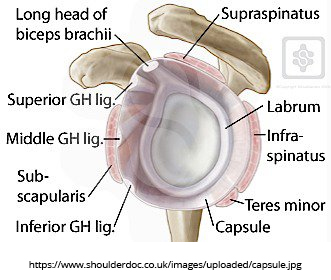By Daniel Zambon B.Sc, D.Physio, APAM
The role of the Rotator Cuff and Scapular Stabilisers
The shoulder joint refers to the joint between the head of the humerus and the glenoid (part of the scapula) and is known in medicine and physiotherapy as the gelnohumeral joint. The scapulothoracic, acromioclavicular (AC) and sternoclavicular (SC) joints are also important joints in maintaining optimal movement of the scapula, which acts as the base for the shoulder to move from.
 The shoulder joint is a highly mobile joint with a large range of movement to allow us to perform overhead activities. A consequence of being so mobile is that the shoulder joint is inherently unstable and relies on static and dynamic stabilisers to control the position of the head of the humerus on the glenoid fossa of the scapula.
The shoulder joint is a highly mobile joint with a large range of movement to allow us to perform overhead activities. A consequence of being so mobile is that the shoulder joint is inherently unstable and relies on static and dynamic stabilisers to control the position of the head of the humerus on the glenoid fossa of the scapula.
Static Stabilisers
The static stabilisers are those structures that don’t actively contract like muscles. These include the glenoid labrum, a ring of fibrocartilage that lines the rim of the glenoid fossa and acts to increase the depth and contact of the glenohumeral joint. The joint capsule that surrounds the glenohumeral joint is also an important passive stabilizer of the shoulder joint. Thickenings of the front of the joint capsule form the anterior glenohumeral ligaments which are also important stabilsers of the shoulder joint, particularly in above head activities.
Dynamic Stabilisers
The dynamic stabilisers of the shoulder joint include the actively contracting rotator cuff and scapular stabilising muscles that control scapulohumeral rhythm, that is the coordinated movement of the humerus and scapular together.
The deltoid muscle is a powerful abductor and elevator of the shoulder joint. However, it’s line of pull in isolation means it draws the head of the humerus superiorly and essentially impinges (jams) the structures under the coracoacromial arch such as the biceps tendon, supraspinatus tendon and sub-acromial bursa. This is generally known as shoulder impingement. It is essential that the rotator muscles (infraspinatus, teres minor, supraspinatus and subscapularis) activate in synergy with the deltoid during overhead activities to pull the humeral head inferiorly or downwards and prevent shoulder impingement. This is the reason that your physiotherapist will often prescribe external rotation exercises in different ranges of abduction to ensure that the rotator cuff muscles are being activated in different arm positions, so as to reduce impingement and subsequently, your pain.
Scapulohumeral rhythm is also very important to avoid shoulder impingement. The muscles controlling scapula position and the posture of the thoracic spine are very important to ensure the functional space under the coracoacromial arch is maximized to clear the path of the humerus in elevation.
These muscles need to hold the scapula back (retracted), up (posteriorly tilted) and out (externally rotated) to achieve this. Even if the rotator cuff is working well, poor scapula mechanics (scapula dyskinesia) can cause impingement and shoulder pain. To achieve full elevation (180 degrees), there is approximately 120 degrees elevation at the glenohumeral joint and 60 degrees elevation at the scapulothoracic joint. This is important to clear the coracoacromial arch from the path of the humerus and to move the glenoid underneath the humerus to support it in higher ranges of elevation. This is the reason your physiotherapist may prescribe exercises to activate particular muscles controlling scapular position such as the trapezius, serratus anterior and rhomboids. Your physiotherapist might also use manual techniques such as soft tissue and joint mobilisation or manipulation to release any tight structures which may be preventing normal movement of the scapula or use tape to increase your awareness of the position of your scapula.
References
Kibler, W.B., Murrell, G.A., & Pluim, B. (2012). Shoulder Pain. In P. Brukner, & K.Khan (Eds.). Clinical sports medicine (pp. 342-344). North Ryde, Australia: McGraw-Hill Education.



